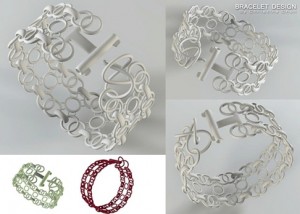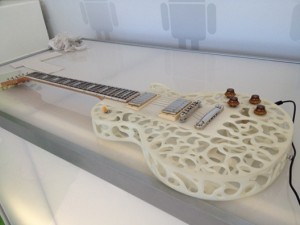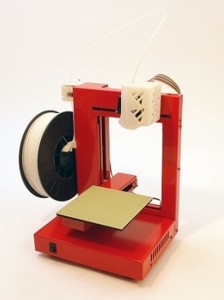Thinking of getting into the world of 3D printing, but don’t need all the bells and whistles? If you’re on a budget, the Afinia 3D printer is probably the best choice for you. The Afinia 3D printer is essentially an upgraded, rebranded version of the UP! Printer. The technical specs are more or less the same, and the Afinia is small, unobtrusive, easy to use and pretty cheap at about $1500.
It also comes with a spool of filament (ABS plastic), some tools (knives, pliers, tweezers) and other 3D printing paraphernalia. This start-up package makes the Afinia a perfect out-of-the-box 3D printer for any beginner.
Click here to check Amazon’s latest price for the Afinia 3D printer!
How does it work?
The Afinia 3D printer uses a process known as TPE, or thermoplastic extrusion. In this particular version of the TPE process, the printing is done by depositing a thin (1.75mm in diameter) filament of thermoplastic onto a heated pad through a hot print head.
The print head can reach temperatures of up to 260 degrees Celsius, and moves on the Y horizontal axis. The heated build pad moves too, both on the horizontal X and vertical Z axes. This allows the printed object to be “drawn” layer by layer in molten plastic in 3D. The supports are auto-generated by the software and printed as needed.
The following video shows an Afinia 3D Printer in action (the printing itself starts five minutes in).
Click here to buy the Afinia 3D Printer right now!
How difficult is it to set up the Afinia 3D printer?
This, and the low price, is the the Afinia’s selling point. The Afinia 3D printer works straight out of the box! There’s no need to spend time putting it together. All you have to do is remove some shipping clips, attach the filament spool arm, and install the software, which is a simple process. Next comes the calibration (don’t worry, there’s nothing hard here too, and of course the printer comes with a clear and comprehensive guide).
After that you mount the spool, feed the filament into the machine, and voila – the Afinia is ready to print. The whole setup process shouldn’t take more than two hours, following the simple instructions included with the printer. Afinia Printing even has videos showing the setup (well, partially, but still helpful)!
What materials can be used?
 The Afinia 3D printer uses spools of thermoplastic filament 1.75mm in diameter. You can hypothetically use any kind of thermoplastic-like material that has a melting temperature of up to 260 degree Celsius (that’s as hot as the the Afinia’s untweaked printhead can go), but the most common (and most available) types of plastic are ABS and PLA.
The Afinia 3D printer uses spools of thermoplastic filament 1.75mm in diameter. You can hypothetically use any kind of thermoplastic-like material that has a melting temperature of up to 260 degree Celsius (that’s as hot as the the Afinia’s untweaked printhead can go), but the most common (and most available) types of plastic are ABS and PLA.
The printer ships with a spool of ABS. ABS tends to behave better when deposited on a heated print-bed (which the Afinia has), and doesn’t need significant cooling. PLA, on the other hand, requires a cooling fan to prevent the material from curling at the corners.
The small print size can be circumvented by gluing printed parts together. That’s a tiny bit easier to do with ABS, as it can be bonded with solvents like acetone in addition to adhesives. The only real advantage that PLA has is the smell of the fumes – ABS can smell unpleasant in enclosed areas. Both aren’t toxic, however. In general, you will get marginally better results when ABS plastic is used.
One final bonus: The Afinia 3D printer creates supports with the default software configuration!
What can you make with the Afinia 3D Printer?
 This printer is comparable to others on the market that use TPE technology. The limitations of the Afinia 3D printer are the limited material selection, small build size and strength of the product. Parts printed with the Afinia are generally 30% as strong as injection-molded pieces.
This printer is comparable to others on the market that use TPE technology. The limitations of the Afinia 3D printer are the limited material selection, small build size and strength of the product. Parts printed with the Afinia are generally 30% as strong as injection-molded pieces.
The Afinia is limited in terms of build-size. It’s 140 x 140 x 135 mm. Compare that to that RapMan, which can build parts roughly twice as large, and costs approximately the same, if the cheapest RapMan kit is purchased.
On the other hand, the Afinia 3D printer is much, much easier to setup – just two hours versus thirty hours or more. And you can print pretty much anything the RapMan can print, provided you scale it down a little or think of a way to break up the final design into smaller pieces. I think it’s safe to say that you can build anything from Thingiverse, and more.
Since the Afinia has a resolution of 0.15mm with the latest software upgrade,you can print items in very fine detail. And given the color-choice of materials and the option to paint the finished part yourself, you can make some very beautiful things like a bracelet or a guitar.
The best part, of course, is that you get to design them yourself! Of course, you aren’t limited to just decorative trinkets. The Afinia can print practical things just as well.
What are the technical specs?
Afinia’s specs are essentially the same as the Cube 3D, with upgraded electronics and software.
| Technology | FFF (Fused Filament Fabrication) aka TPE (Thermoplastic Extrusion) |
| Frame size (Width x Depth x Height) |
~ 9- 5/8″ x10-1/4″ x13-3/4″ /~ 25 x 26 x 35 cm |
| Weight | ~ 11lbs / 5 kg |
| Build materials | 1.75mm PLA filament, ABS plastic (preferable) |
| Accuracy | 0.15 mm |
| Build volume (X,Y,Z) |
5 -1/2″(w) x 5-1/2″(d) x 5-1/4″(h) / ~140 x 140 x 135 mm |
| Power requirements | 100-240 VAC, 50-60 Hz, 200W |
| Special facilities/ventilation | None required. The ambient temperature should be60F-85F, and the relative humidity should be 20%-50% |
| OS compatibility | Windows XP/Vista/7 and Mac OS 10.6 and above compatible |
| Software used | Afinia software |
How much does it cost?
The Afinia 3D printer costs very little to purchase and operate. The printer costs approximately $1500, and the materials starts at $31.99/kg, or $0.02/cm3.
Summary
The Afina is surprisingly easy to use. It requires almost no setup in comparison to other 3D printers and the software is intuitive and creates supports on the fly.
In fact, as of writing, there are very few bad reviews of this printer. It’s an all-around decent printer, starting with the build quality of the printer itself and the quality of printed parts, and ending with the software and tech support.
The main drawback is that the Afinia has a small build size. You may note that it’s more expensive than the RapMan extreme, but you should take into account the supplies that come with the Afinia and the fact that will save some thirty hours of setup time.
Overall, the Afinia 3D printer provides a lot of bang for your buck, especially if you’re in the market for a budget priced 3D printer!
Head over to the 3D printer Review Page for more 3D printer reviews!

